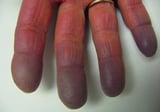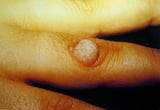Can I Use Otc Freeze for Filiform Warts Read More: Http://moleremovalat.com/types-of-warts
Warts are common, benign, epidermal lesions caused by human papillomavirus infection. They can appear anywhere on the body in a diversity of morphologies. Diagnosis is past test. Warts are usually cocky limited simply may be treated by subversive methods (eg, excision, cautery, cryotherapy, liquid nitrogen) and topical or injected agents.
Warts are almost universal in the population; they bear upon patients of all ages but are virtually common among children and are uncommon among older people.
-
1. Haley CT, Mui UN, Vangipuram R, et al: Human oncoviruses: Mucocutaneous manifestation, pathogenesis, therapeutics, and prevention. Papillomaviruses and Merkel prison cell polyomavirus. J Am Acad Dermatol 81:1–21, 2019. doi: ten.1016/j.jaad.2018.09.062
Symptoms and Signs of Warts
Common warts
Common warts (verrucae vulgaris) are caused by HPV types 1, 2, iv, and 7 and occasionally other types in immunosuppressed patients (eg, 75 to 77). They are usually asymptomatic just sometimes crusade balmy pain when they are located on a weight-bearing surface (eg, bottom of the feet). Common warts are sharply demarcated, rough, circular or irregular, business firm, and light gray, yellow, brown, or gray-black nodules 2 to 10 mm in bore. They appear most oftentimes on sites subject to trauma (eg, fingers, elbows, knees, face) but may spread elsewhere. Variants of unusual shape (eg, pedunculated or resembling a cauliflower) appear nigh frequently on the head and neck, especially the scalp and bristles area.
Filiform warts
These warts are long, narrow, frondlike growths, usually located on the eyelids, face, neck, or lips. They are normally asymptomatic. This morphologically singled-out variant of the common wart is benign and piece of cake to treat.
Flat warts
Apartment warts, caused past HPV types 3 and x and occasionally 26 to 29 and 41, are smoothen, flat-topped, xanthous-brown, pink, or mankind-colored papules, most frequently located on the face and along scratch marks; they are more common among children and young adults and develop by autoinoculation. They more often than not cause no symptoms simply are usually hard to treat.
Palmar warts and plantar warts
Mosaic warts
Mosaic warts are plaques formed by the coalescence of myriad smaller, closely prepare plantar warts. Every bit with other plantar warts, they are often tender.
Periungual warts
Genital warts
-
Clinical evaluation
-
Rarely biopsy
Diagnosis of warts is based on clinical advent; biopsy is rarely needed. A cardinal sign of warts is the absence of pare lines crossing their surface and the presence of pinpoint black dots (thrombosed capillaries) or bleeding when warts are shaved.
Differential diagnosis of warts includes the following:
DNA typing of the virus is available in some medical centers merely is more often than not not needed.
Many warts regress spontaneously (specially common warts); others persist for years and recur at the same or different sites, even with treatment. Factors influencing recurrence appear to be related to the patient'south overall allowed status as well every bit local factors. Patients subject to local trauma (eg, athletes, mechanics, butchers) may have recalcitrant and recurrent HPV infection. Genital HPV infection has malignant potential, but malignant transformation is rare in HPV-induced skin warts, except among immunosuppressed patients.
-
Topical irritants (eg, salicylic acid, cantharidin, podophyllum resin)
-
Destructive methods (eg, cryosurgery, electrocautery, curettage, excision, light amplification by stimulated emission of radiation)
-
Other topical therapies, intralesional injection therapies, or combinations
There are no firm indications for handling of warts. Treatment should exist considered for warts that are cosmetically unacceptable, in locations that interfere with function, or painful. Patients should be motivated to adhere to treatment, which may require a prolonged course and can be unsuccessful. Treatments are less successful in patients with impaired allowed systems.
Mechanisms of many irritants include eliciting an immune response to HPV. Such irritants include salicylic acid (SCA), trichloroacetic acid, 5-fluorouracil, podophyllum resin, tretinoin, and cantharidin.
Topical imiquimod 5% cream induces pare cells to locally produce antiviral cytokines. Topical cidofovir and contact immunotherapy (eg, squaric acid dibutyl ester and Candida antigen) take been used to treat warts. Warts can starting time exist soaked in hot water at 113° F for 30 minutes ≥ 3 times/week. After soaking, the skin is more permeable to topical drugs. Candida antigen can also exist injected directly into the lesions.
Oral treatments include cimetidine (which has questionable efficacy), isotretinoin, and zinc. Four cidofovir can also be used. In most instances, modalities should be combined to increase the likelihood of success. Straight antiviral effects can exist achieved with intralesional injection of bleomycin and interferon alfa-2b, merely these treatments are reserved for the well-nigh recalcitrant warts.
These drugs can exist used in combination with a subversive method (eg, cryosurgery, electrocautery, curettage, excision, laser) because even though a wart may exist physically removed by a subversive method, virus may remain in the tissues and crusade recurrence.
In immunocompetent patients, mutual warts commonly spontaneously regress within 2 to 4 years, merely some linger for many years. Numerous treatments are available. Destructive methods include electrocautery, cryosurgery with liquid nitrogen, and light amplification by stimulated emission of radiation surgery. Salicylic acrid (SCA) preparations are also normally used.
Which method is used depends on the location and severity of involvement.
Salicylic acid is the most common topical agent used. SCA is bachelor as a liquid or plaster or impregnated within tape. For example, 17% liquid SCA can exist used on the fingers, and 40% plaster SCA tin be used on the soles. Patients utilize SCA to their warts at night and get out it on for 8 to 48 hours depending on the site.
Cantharidin can exist used alone or in combination (1%) with SCA (xxx%) and podophyllum (five%) in a collodion base. Cantharidin alone is removed with soap and water after 6 hours; cantharidin with SCA or podophyllum is removed in 2 hours. The longer these agents are left in contact with the skin, the more than brisk the baking response.
Cryosurgery is painful but extremely effective. Electrodesiccation with curettage, laser surgery, or both is effective and indicated for isolated lesions but may cause scarring. Recurrent or new warts occur in most 35% of patients inside 1 year; therefore, methods that scar should be avoided equally much every bit possible so that multiple scars do not accumulate. When possible, scarring treatments are reserved for cosmetically unimportant areas and recalcitrant warts.
Treatment of filiform warts is removal with scalpel, pair of scissors, curettage, or liquid nitrogen. Liquid nitrogen should be applied and so that up to 2 mm of peel surrounding the wart turns white. Impairment to the skin occurs when the skin thaws, which usually takes x to twenty seconds. Blisters can occur 24 to 48 hours after treatment with liquid nitrogen. Intendance must exist taken when treating cosmetically sensitive sites, such as the face and cervix, because hypopigmentation or hyperpigmentation frequently occurs subsequently treatment with liquid nitrogen. Patients with darkly pigmented peel tin develop permanent depigmentation.
Treatment of flat warts is hard, and flat warts are ofttimes longer-lasting than common warts, recalcitrant to treatments, and, in cosmetically of import areas, make the almost effective (destructive) methods less desirable. Usual first-line handling is daily tretinoin (retinoic acrid 0.05% foam). If peeling is not sufficient for wart removal, another irritant (eg, five% benzoyl peroxide) or 5% SCA cream can be applied sequentially with tretinoin. Imiquimod 5% cream can be used alone or in combination with topical drugs or destructive measures. Topical 5-fluorouracil (1% or 5% foam) tin can also be used.
Treatment of plantar warts is vigorous maceration with 40% SCA plaster kept in place for several days. The wart is and so debrided while clammy and soft, followed by destruction by freezing or using caustics (eg, 30 to 70% trichloroacetic acrid). Other subversive treatments (eg, CO2 laser, pulsed-dye light amplification by stimulated emission of radiation, diverse acids) are frequently constructive.
Combination therapy with liquid nitrogen and imiquimod 5% cream, tretinoin, or SCA is effective and normally safer than liquid nitrogen lone or cautery. Using liquid nitrogen and cautery to treat periungual and lateral finger warts should be done carefully considering overly ambitious treatment tin can cause permanent boom deformity and rarely nerve injury.
Several methods whose long-term value and risks are not fully known are bachelor for the treatment of recalcitrant warts. Intralesional injection of small amounts of a 0.1% solution of bleomycin in saline often cures stubborn plantar and periungual warts. Even so, Raynaud syndrome Raynaud Syndrome Raynaud syndrome is vasospasm of parts of the hand in response to common cold or emotional stress, causing reversible discomfort and color changes (pallor, cyanosis, erythema, or a combination) in... read more  or vascular impairment may develop in injected digits, especially when the drug is injected at the base of operations of the digit, so caution is warranted. Intralesional Candida antigen has also been reported to be moderately effective for recalcitrant warts. Interferon, specially interferon alfa, given intralesionally (iii times/week for three to 5 weeks) or intramuscularly, has too cleared recalcitrant skin and genital warts. All-encompassing warts sometimes abate or articulate with oral isotretinoin or acitretin. The nine-valent HPV vaccine has been reported every bit useful for recalcitrant warts in children, but efficacy of this intervention is not proved (2 Treatment references Warts are common, benign, epidermal lesions acquired by human papillomavirus infection. They can appear anywhere on the body in a variety of morphologies. Diagnosis is by examination. Warts are... read more than
or vascular impairment may develop in injected digits, especially when the drug is injected at the base of operations of the digit, so caution is warranted. Intralesional Candida antigen has also been reported to be moderately effective for recalcitrant warts. Interferon, specially interferon alfa, given intralesionally (iii times/week for three to 5 weeks) or intramuscularly, has too cleared recalcitrant skin and genital warts. All-encompassing warts sometimes abate or articulate with oral isotretinoin or acitretin. The nine-valent HPV vaccine has been reported every bit useful for recalcitrant warts in children, but efficacy of this intervention is not proved (2 Treatment references Warts are common, benign, epidermal lesions acquired by human papillomavirus infection. They can appear anywhere on the body in a variety of morphologies. Diagnosis is by examination. Warts are... read more than  ).
).
-
ii. Kost Y, Zhu Thursday, Blasiak RC: Clearance of recalcitrant warts in a pediatric patient following administration of the ix-valent human papillomavirus vaccine. Pediatr Dermatol 37(4):748–749, 2020. doi: 10.1111/pde.14150
-
Cutaneous warts are acquired past homo papillomaviruses, are very common, and have multiple forms.
-
Spread is unremarkably by autoinoculation and is facilitated past trauma and maceration.
-
Well-nigh warts are asymptomatic but can exist mildly painful with pressure.
-
Most warts resolve spontaneously, particularly common warts.
-
Treatments, when indicated, unremarkably include topical irritants (eg, salicylic acid, cantharidin, podophyllum resin) and/or destructive methods (eg, cryosurgery, electrocautery, curettage, excision, laser).
-
Recalcitrant warts tin be treated with other intralesional and oral drugs as well as the 9-valent HPV vaccine.
Source: https://www.msdmanuals.com/en-in/professional/dermatologic-disorders/viral-skin-diseases/warts
0 Response to "Can I Use Otc Freeze for Filiform Warts Read More: Http://moleremovalat.com/types-of-warts"
Post a Comment